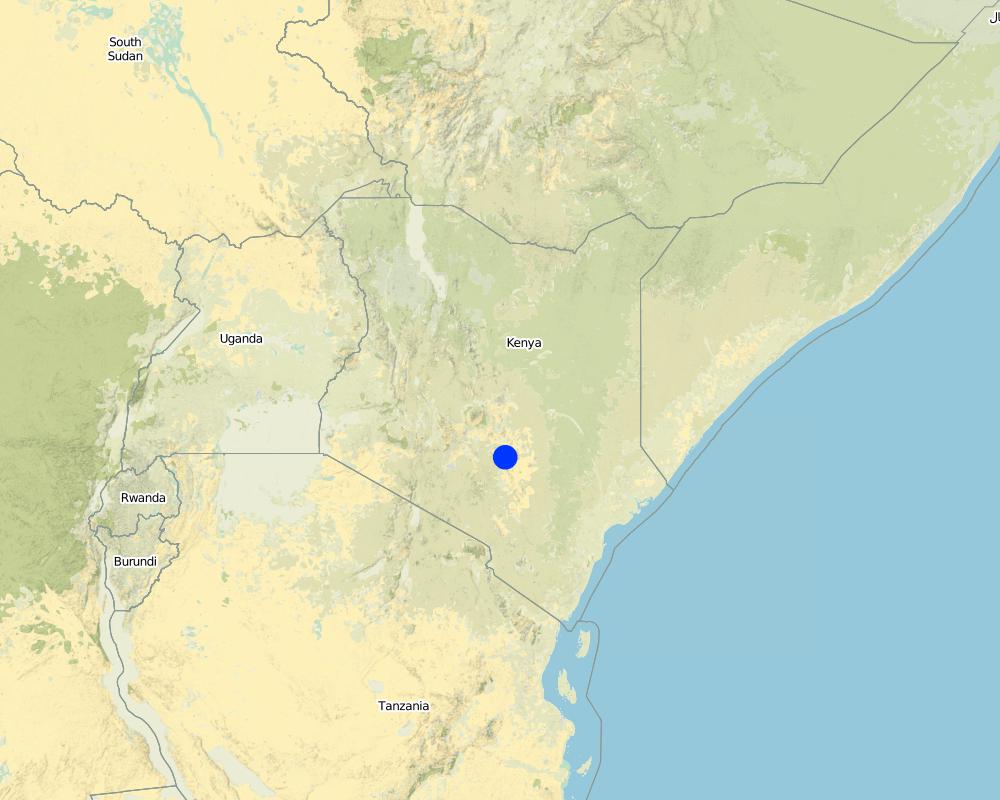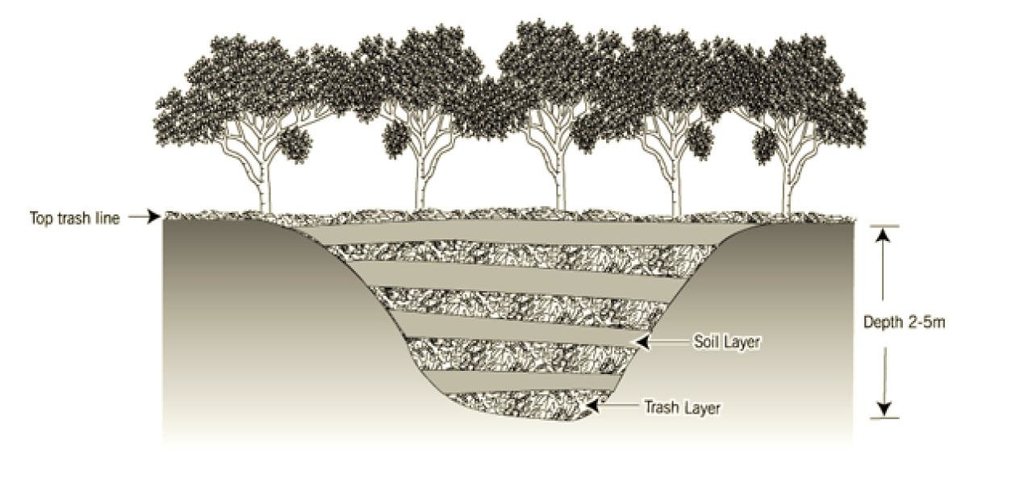Gully blocking by stone checks [肯尼亚]
- 创建:
- 更新:
- 编制者: Kithinji Mutunga
- 编辑者: –
- 审查者: David Streiff, Alexandra Gavilano
technologies_1490 - 肯尼亚
查看章节
全部展开 全部收起1. 一般信息
1.2 参与该技术评估和文件编制的资源人员和机构的联系方式
SLM专业人员:
Mburu Charles
MOARD
肯尼亚
SLM专业人员:
Kameti Stephen
MOARD
肯尼亚
有助于对技术进行记录/评估的机构名称(如相关)
Food and Agriculture Organization of the United Nations (FAO) - 意大利1.3 关于使用通过WOCAT记录的数据的条件
编制者和关键资源人员接受有关使用通过WOCAT记录数据的条件。:
是
2. SLM技术的说明
2.1 技术简介
技术定义:
Blocking of a gully by use of stone checks in order to impede runoff and improve soil moisture for crop production
2.2 技术的详细说明
说明:
Stone checks are constructed across the gully at horizontal intervals of 10 - 15 m. The check dams vary in size, but are generally 1- 1.5 m high, 1 m wide at the top (base width is greater) and stretch for some 5 - 10 metres across the gully. The checks are flat across the top, except for one end which is lowered to act as a spillway for overflow. As has been pointed out already, these are constructed in stages every rainy season, keeping pace with the rate of siltation. Stone for construction is collected from around the farm. These
checks slow down runoff, encourage sedimentation of organically rich deposits and create a moist and fertile gully bed, suited to crop production. Bananas, pawpaws and annual crops are planted between the stone checks.
Purpose of the Technology: The aim of this technology is to slow down runoff in the gully and harvest the silt. Its purpose is primarily for perennial (and annual) cropping. With respect to
soil and water conservation, impact is achieved through control of concentrated runoff, by retention/ trapping of sediment, by reduction of slope and thereby reclamation of land within a gully.
Establishment / maintenance activities and inputs: Maintenance is a continuous process. There is a regular demand for adding more layers to the check dams as they silt up, and an occasional need to repair broken checks.
Natural / human environment: Mwaniki Mutembei is a young family man, who took the decision some years ago to devote his energies to farming. As he expressed in his interview in the PFI video, he became disillusioned with casual contract labour, and decided to work for himself instead, on his own land. Although he has 4 hectares of farmland, it is situated in one of the driest sub-locations of Migwani, namely Thitani, and the land itself is infertile and shallow. Mwaniki is certainly resource-poor.
2.3 技术照片
2.5 已应用该技术的、本评估所涵盖的国家/地区/地点
国家:
肯尼亚
区域/州/省:
Eastern Province
具体说明该技术的分布:
- 均匀地分布在一个区域
如果技术均匀分布在一个区域,则指定覆盖的区域(单位为平方千米):
0.04
如果不知道精确的区域,请注明大致覆盖的区域:
- 0.1-1 平方千米
注释:
Total area covered by the SLM Technology is 0.04 km2.
technology covers a portion of the farm.
Map
×2.6 实施日期
如果不知道确切的年份,请说明大概的日期:
- 50多年前(传统)
2.7 技术介绍
详细说明该技术是如何引入的:
- 作为传统系统的一部分(> 50 年)
注释(项目类型等):
It was a person intiative
3. SLM技术的分类
3.1 该技术的主要目的
- 减少、预防、恢复土地退化
3.2 应用该技术的当前土地利用类型

农田
- 一年一作
每年的生长季节数:
- 2
具体说明:
Longest growing period in days: 120 Longest growing period from month to month: Apr - Jul Second longest growing period in days: 90 Second longest growing period from month to month: Oct - Jan
注释:
Major land use problems (compiler’s opinion): soil infertility due to washing of important nutients through leaching. Lack of technology by the land users
Major land use problems (land users’ perception): lack of tools, credit. Proper trainingand market information market. Poor access roads
3.4 供水
该技术所应用土地的供水:
- 雨养
3.5 该技术所属的SLM组
- 土壤肥力综合管理
- 引水和排水
3.6 包含该技术的可持续土地管理措施

结构措施
- S5:大坝、集水斗、水池
注释:
Main measures: structural measures
3.7 该技术强调的主要土地退化类型

土壤水蚀
- Wt:表土流失/地表侵蚀
- Wg:冲沟侵蚀/沟蚀

化学性土壤退化
- Cn:肥力下降和有机质含量下降(非侵蚀所致)

水质恶化
- Ha:干旱化
注释:
Main type of degradation addressed: Wg: gully erosion / gullying
Secondary types of degradation addressed: Wt: loss of topsoil / surface erosion, Cn: fertility decline and reduced organic matter content, Ha: aridification
4. 技术规范、实施活动、投入和成本
4.1 该技术的技术图纸
技术规范(与技术图纸相关):
Stone checks in the gully: note side spillways
Kenya
Technical knowledge required for field staff / advisors: moderate
Technical knowledge required for land users: high
Main technical functions: control of concentrated runoff: impede / retard, increase / maintain water stored in soil
Secondary technical functions: control of concentrated runoff: retain / trap, reduction of slope length, sediment retention / trapping, sediment harvesting, improvement of soil structure, increase in soil fertility
Construction material (earth): acquired from the side of the gully
Construction material (concrete): to reinforce the gully
Vegetation is used for stabilisation of structures.
4.2 有关投入和成本计算的一般信息
其它/国家货币(具体说明):
Kenya shillings
如相关,注明美元与当地货币的汇率(例如1美元=79.9巴西雷亚尔):1美元=:
70.0
注明雇用劳工的每日平均工资成本:
2.14
4.3 技术建立活动
| 活动 | 时间(季度) | |
|---|---|---|
| 1. | layout of the embankment | dry season |
| 2. | widening of the gully | dry season |
| 3. | planting of stabiliser | rain season |
4.4 技术建立所需要的费用和投入
注释:
Duration of establishment phase: 48 month(s)
4.5 维护/经常性活动
| 活动 | 时间/频率 | |
|---|---|---|
| 1. | repair of embankments | dry season/occasional |
| 2. | addition of more layers of check | dry season/seasonally |
| 3. | planting of grass, trees | rain season/seasonally |
4.6 维护/经常性活动所需要的费用和投入(每年)
注释:
length of the structures
4.7 影响成本的最重要因素
描述影响成本的最决定性因素:
cost of labour. Slope
5. 自然和人文环境
5.1 气候
年降雨量
- < 250毫米
- 251-500毫米
- 501-750毫米
- 751-1,000毫米
- 1,001-1,500毫米
- 1,501-2,000毫米
- 2,001-3,000毫米
- 3,001-4,000毫米
- > 4,000毫米
农业气候带
- 半干旱
- 干旱
5.2 地形
平均坡度:
- 水平(0-2%)
- 缓降(3-5%)
- 平缓(6-10%)
- 滚坡(11-15%)
- 崎岖(16-30%)
- 陡峭(31-60%)
- 非常陡峭(>60%)
地形:
- 高原/平原
- 山脊
- 山坡
- 山地斜坡
- 麓坡
- 谷底
垂直分布带:
- 0-100 m a.s.l.
- 101-500 m a.s.l.
- 501-1,000 m a.s.l.
- 1,001-1,500 m a.s.l.
- 1,501-2,000 m a.s.l.
- 2,001-2,500 m a.s.l.
- 2,501-3,000 m a.s.l.
- 3,001-4,000 m a.s.l.
- > 4,000 m a.s.l.
5.3 土壤
平均土层深度:
- 非常浅(0-20厘米)
- 浅(21-50厘米)
- 中等深度(51-80厘米)
- 深(81-120厘米)
- 非常深(> 120厘米)
土壤质地(表土):
- 粗粒/轻(砂质)
- 中粒(壤土、粉土)
表土有机质:
- 中(1-3%)
如有可能,附上完整的土壤描述或具体说明可用的信息,例如土壤类型、土壤酸碱度、阳离子交换能力、氮、盐度等。:
Soil texture (topsoil): Also fine
Soil fertility is medium - high
Soil drainage / infiltration is good - poor
Soil water storage capacity is low - high
5.6 应用该技术的土地使用者的特征
非农收入:
- 低于全部收入的10%
相对财富水平:
- 贫瘠
- 平均水平
机械化水平:
- 手工作业
- 畜力牵引
说明土地使用者的其他有关特征:
Population density: 10-50 persons/km2
Annual population growth: 2% - 3%
5% of the land users are rich and own 35% of the land.
50% of the land users are average wealthy and own 40% of the land.
30% of the land users are poor and own 20% of the land.
15% of the land users are poor and own 5% of the land.
Off-farm income specification: few employed persons outside
5.8 土地所有权、土地使用权和水使用权
土地所有权:
- 个人,未命名
土地使用权:
- 租赁
- 个人
6. 影响和结论性说明
6.1 该技术的现场影响
社会经济效应
生产
作物生产
注释/具体说明:
bananas and pawpaws
生产区域
注释/具体说明:
500 square metres
收入和成本
农业收入
生态影响
水循环/径流
地表径流
SLM之前的数量:
50
SLM之后的数量:
10
土壤
土壤流失
SLM之前的数量:
5.5
SLM之后的数量:
0
6.4 成本效益分析
技术收益与技术建立成本相比如何(从土地使用者的角度看)?
短期回报:
轻度消极
长期回报:
积极
技术收益与技术维护成本/经常性成本相比如何(从土地使用者的角度看)?
短期回报:
中性/平衡
长期回报:
非常积极
6.5 技术采用
- 1-10%
如若可行,进行量化(住户数量和/或覆盖面积):
12 households and they cover an area of 1 percent
在所有采用这项技术的人当中,有多少人是自发的,即未获得任何物质奖励/付款?:
- 91-100%
注释:
12 land user families have adopted the Technology without any external material support
Comments on spontaneous adoption: estimates
There is a little trend towards spontaneous adoption of the Technology
Comments on adoption trend: As the main work of construction, involving superficial quarrying of stone, is very labour demanding, it makes the technology expensive to undertake. Because of this, and also due to the fact that it is a
very site specific technology, adoption has so far been limited to a handful of farmers locally.
6.7 该技术的优点/长处/机会
| 编制者或其他关键资源人员认为的长处/优势/机会 |
|---|
| Making use of generally infertile and unproductive land by creatively manipulating a gully |
| Increased land area for production |
| Increased crop yield (bananas and pawpaws) and improved farm income |
7. 参考和链接
7.1 信息的方法/来源
7.2 参考可用出版物
标题、作者、年份、ISBN:
PFI Mid term evaluation report. 1998.
可以从哪里获得?成本如何?
PFI Mwingi box 319 Mwingi
标题、作者、年份、ISBN:
PFI Regional workshop report. 1999.
可以从哪里获得?成本如何?
PFI Mwingi box 319 Mwingi
标题、作者、年份、ISBN:
Kithinji M., Critchley W. 2001. Farmers' initiatives in land husbandry: Promising technologies for the drier areas of East Africa. RELMA Technical Report series no. 27
链接和模块
全部展开 全部收起链接
无链接
模块
无模块





